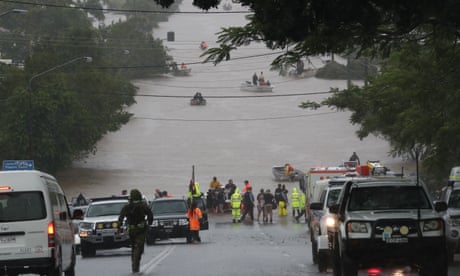- by foxnews
- 12 Mar 2025
With another La Niña under way, experts warn Australia’s east coast remains at high risk
With another La Niña under way, experts warn Australia’s east coast remains at high risk
- by theguardian
- 25 Sep 2022
- in news

Rain lashed parts of the east coast again on Thursday's public holiday, and on Friday morning residents of northern New South Wales and southern Queensland were warned of more flooding. Another climate driver, the Indian Ocean dipole, is in a negative phase, fuelling heavy rains and renewed flooding in inland NSW.
WaterNSW warned this week that Warragamba Dam, west of Sydney, was at 97.8% of its storage capacity.
The dam has received almost twice its usual expected volume of water over the past 18 months. That has prompted the agency to release 1,000GL - half its capacity - since November 2021, a step it said had reduced the storage level "as much as is permitted under its operating rules". But it is full anyway, with more rain forecast.
How best to prepare communities - some hit by multiple disasters since the black summer bushfires - for another potential season of heavy rain and floods is a question experts say should be occupying all levels of government. They see several options for the immediate and longer term.
Former NSW fire and rescue commissioner and founder of Emergency Leaders for Climate Action, Greg Mullins, says the disasters are compounding and emergency responders are becoming overwhelmed.
He wants more focus on prevention and preparation, and welcomes the Albanese government's establishment of a single national emergency management agency.
"What I realised as a commissioner is that every dollar you put into prevention led to more lives and properties saved," he says.
Mullins says this could include training communities as first responders, providing grants for home modifications, and establishing more targeted communications to ensure every community knows its level of risk and what to do in an emergency.
In the case of floods, he says the answer is obvious: "We've got to move people off flood plains."
Prof Jamie Pittock, from the Australian National University, agrees governments need to change their approach to development in flood zones, and accelerate buyouts.
"Stop putting people in harm's way," he says.
"We have places in the Hawkesbury and Nepean valley that have been flooded four times in two years. The recent NSW [inquiry] report told the government to get on with buybacks."
NSW Greens MLC Sue Higginson says she is not convinced governments have shown enough leadership since the floods inquiry.
Higginson, who wrote about the catastrophe in Lismore as it unfolded in March, describes two immediate reactions to the news. The first was simply "oh my gosh."
"But the other is: what do we do differently this time around?"
In a recent parliamentary hearing Higginson asked officials if more boats had been bought for rescues in the northern rivers. She was told resources were being maintained, boats were available but "there aren't any extra up there."
She also asked what plans were in place to ensure evacuation centres were ready and equipped.
"I don't see how we're better prepared," she says. "We've got a displaced community. We've got homeowners north and south that don't know what the future holds."
The NSW State Emergency Service (SES) says it is "continually training volunteers, implementing new assets and equipment and working proactively with at-risk communities".
An SES spokesperson said it had received 3,452 new membership applications since the February and March floods, from which 1,375 new members had been recruited, with the remainder under assessment.
They said the service had trained more managers, increased its capacity for taking calls and was transitioning to the Australian Warning System, which will bring a nationally consistent approach to emergency warnings.
Prof Stuart Khan, from the school of civil and environmental engineering at the University of New South Wales, says governments need to ensure that basic infrastructure and communication systems are working.
This includes making sure evacuation routes are free of potholes and other damage from the record-breaking rains.
With catchments already soaked, Khan has called on state governments to consider flood mitigation measures such as lowering the full supply level of Warragamba Dam.
This would not prevent a flood, but Khan says it could help to delay one, giving people more time to evacuate, and reduce the peak.
He says the supply level could be carefully lowered over a month, and the government could consider whether to maintain that level indefinitely.
He stresses this would be a complex process because 80GL of Sydney's drinking water supply would need to be replaced through options such as desalination.
But he says it could be beneficial in wet and dry years.
"When you reduce the full supply level and replace that 80GL you get not only more flood mitigation but more drought resilience," he says.
Pittock says water could also be released from Queensland's Wivenhoe Dam and from the reservoirs and headwaters of the Murray-Darling basin.
Releasing water from parts of the Murray-Darling basin would deliver an environmental benefit to wetlands, he says, some of which are still "high and dry".
Tim Beshara, of the Wilderness Society, wants to see the federal government do more to prepare for the environmental effects of disasters.
He says the federal government only intervenes on a case-by-case basis, "largely after the event, if at all".
"There is no standing fund that, for instance, wildlife rescuers or scientists could draw on when a disaster hits to protect special places or endangered species," he says.
"All of these worsening climate-fuelled events impact on nature in different ways, but none of our systems are set up to be ready for major events, and to intervene when they happen."
Prof Mark Gibbs, a coastal management expert at the Queensland University of Technology, says all floods expose households who "don't realise they are vulnerable and unfortunately work that out the hard way".
He says people should first check council flood maps and get a sense of how close they are to potential flood zones.
The next step is to have a plan if there is a chance they may be exposed.
"Go through the scenario - what if flood waters come up the street, what are you going to do?" he says. "Have a conversation at the dinner table. If this happened, what would you do?"
The NSW and Queensland governments provide information on flood risk and preparation. A spokesperson for the NSW SES said any plan should include knowing where to go in an evacuation, checking on neighbours and knowing what to do with pets or other animals.
The NSW SES recommends simple home maintenance to prepare for storms, such as cleaning gutters, tying down items and general maintenance.
It suggests preparing an emergency kit with items such as torches, water, important paperwork, medications and other essentials.
Higginson says one common experience in Lismore was that people lost important documents such as birth certificates and title deeds.
"Are people ready with things stored in a place that can be quickly located and moved?" she says.
- by foxnews
- descember 09, 2016
Daring airport trend has travelers arriving at gate 15 minutes before takeoff
Flight passengers are participating in the new viral trend, "airport theory," with flyers arriving at their gates 15 minutes before their flights depart. A travel expert weighs in.
read more


